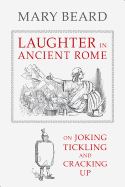
In Laughter in Ancient Rome, classicist and social commentator Mary Beard (The Fires of Vesuvius) addresses not only the questions of when, how and why ancient Romans laughed, but what their "laugh culture" tells us about their society--and ours.
After a brief introduction in which Beard considers two examples of laughter from Roman history, the book is divided into two parts. The first looks at theories of laughter (ancient and modern), the methodological difficulties of writing a history of laughter, the differences between Roman laughter in Latin and Greek texts, and the question of what we mean by "that superficially unproblematic adjective Roman." The second part focuses on four aspects of Roman laughter: the famous orator Cicero's discussion of the proper (and improper) ways to evoke laughter in an audience, the relationship between laughter and power in ancient Rome, the importance of mimicry in Roman humor, and the Roman joke book known as the "laughter lover." Along the way, Beard debunks the popular image of Saturnalia as the precursor to Carnival, argues that smiling is a social construct, looks at the Roman roots of "monkey business" and stops just short of claiming that the joke as we know it was a Roman invention.
Written in Beard's trademark combination of erudition and effortless prose, Laughter in Ancient Rome is a fascinating combination of history, psychology, linguistic exploration and humor. This is scholarly writing at its best: using a seemingly narrow topic to illuminate larger cultural issues. --Pamela Toler, blogging at History in the Margins

